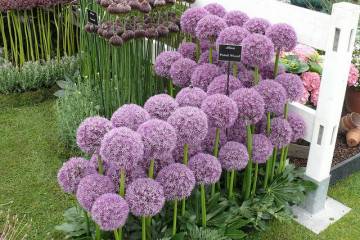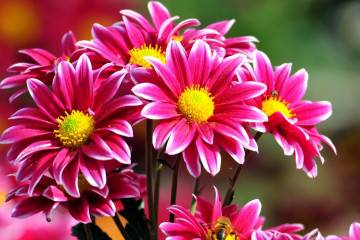Lavender - planting and care outdoors
Content:
- What does lavender look like, which family does it belong to?
- Common varieties of lavender
- Briefly about the history of appearance as a garden plant
- Features of caring for lavender in the garden
- When and how it blooms
- How to propagate lavender outdoors
- Transplanting lavender outdoors
- Potential problems in growing lavender
Lavender is a native of the Mediterranean and is a thermophilic crop. Breeders have developed varieties grown in temperate latitudes. In central Russia, many gardeners grow lavender, planting and care in the open field is not difficult.
What does lavender look like, which family does it belong to?
A perennial evergreen shrub or semi-shrub with long erect stems in some countries is called Colored Grass for the bluish-purple coloration of spike-shaped inflorescences with 6-10 buds.

Popular French lavender forms dense thickets in 5-7 years. It is considered the ancestor of many decorative cold-resistant varieties.
Lavender: cultivation
The bush belongs to the family of clear-flowered, subspecies of blue-flowered, botanical name Lavandula Lamiaceae. In regions with harsh climates, it is grown as an annual plant. The species differ in the shape of the leaves, the color of the buds. Leaves are oblong, long, slightly silvery. The roots are powerful, pivotal, tough.
Common varieties of lavender
About 30 plant species are known, but only narrow-leaved and broad-leaved lavender are used as a source of perfumery and medical raw materials. "Butterfly" is appreciated for its pronounced aroma, multi-cut - for decorativeness.
The most common varieties are:
- toothed forms a wide bush up to 1.5 wide. Shoots grow up to 1 meter. The length of the serrated leaves is up to 4 cm. The shade of the petals is violet-blue. The variety hibernates only under shelters or in basements, tolerates frosts down to -15 ° C. Medium flowering bush;
- broadleaf lavender, better known as French lavender, is grown commercially. Refers to early flowering, flower stalks grow back in April, flowering continues until June. Inflorescences are loose, up to 10 cm long. The height of the stems is from 1 to 1.3 meters. Several varieties have been bred with blue, white, pink, lilac flowers. The variety is distinguished by drought resistance, the temperature for wintering is not lower than -15 ° C;
- narrow-leaved or English true lavender is listed as a medicinal plant in many countries. Botanical name "Angustifolia". The height of the spherical bush is from 60 cm to one meter, the leaves are large, linear, up to 6 cm long. Late flowering variety. The buds persist until the end of September. In snowy winters, the plant calmly tolerates cold up to -20 ° C;
- multi-cut looks like a fern, the foliage is gray-green, openwork. It is a Mediterranean variety of blue-violet lavender. Peduncles up to 60 cm high, a spherical bush blooms in June, buds are formed before early September.

Numerous flower stalks rise above the bush, forming a delicate cloud that exudes a delicate aroma. Multi-cut lavender is beautiful on alpine lawns
Briefly about the history of appearance as a garden plant
The oldest plant is lavender - its cultivation began before our era.
In the tombs of the Egyptian pharaohs, amphorae with lavender oil were found; it was used to embalm bodies. Perfume compositions with lavender have been popular since the Renaissance.
Lavender grows:
- in the Alps;
- on the Mediterranean coast;
- in the mountainous states of India;
- on the Arabian Peninsula;
- in northeastern Africa;
- in the foothills of the Caucasus.
Since the 17th century, the mass cultivation of lavender has begun in Europe. In landscape design, crops are used for border planting, in flower arrangements.
Features of caring for lavender in the garden
A prerequisite is the construction of shelters for the winter, regular loosening of the soil. The rest of the plant is unpretentious, pleases with flowering, regardless of what summer is.

Industrial cultivation of lavender is practiced in European countries. Bushes are formed when harvesting - cutting flowers
Lighting
The culture loves sun-drenched, well-heated areas. Partial shade is possible in the afternoon. In shady places, the plant blooms poorly, the bushes grow frail, often freeze out in winter.
Watering and moisture
Many garden varieties are drought tolerant. The bush will not grow in flooded, waterlogged and flooded areas. Before planting lavender, the soil is drained. The plant is watered only in the heat, when there is no rain for a long time, dew does not fall in the morning.
Spraying and other preventive measures
The density of the peduncles depends on the nutritional value of the soil. During the formation of flower shooters, it is recommended to spray the bushes with preparations with boron, to carry out foliar dressing.
Priming
For a full-fledged root system, loosened soil is needed. Washed gravel, river sand or medium-sized stones are added to the clay soil in a ratio of 1: 5. Leafy soil or compost is mixed with turf 50/50, add 25% humus, ash: at the rate of 1 glass per bucket of earth.
Fertilization and feeding
To feed lavender correctly, you need to use ready-made mixtures of mineral fertilizers. Add superphosphate, lime "by eye" is not worth it, from an overabundance of minerals, the root will start to rot. Nitrogen is applied only in early spring, when the leaves hatch. Fertilizers are applied no more than 2 times per season. It is better to do foliar feeding so that the trace elements are immediately sent to the peduncles, not accumulated in the root system.
How and when to trim
To stimulate the flowering arrows, a circular pruning of the shoots is carried out. Without a "haircut", the stems will be too elongated, bald from below. The lavender bushes in the garden are cut for drying in the middle of flowering. It is believed that at this time they contain the most essential oil.
When and how it blooms
Lavender is a plant that blooms profusely. With good care, the bush is completely covered with buds.
Types of flowers
Lavender flower is a false whorl, collected in a spike-shaped inflorescence. A double-lipped corolla is formed on top.
Flower shapes
The flowers are tubular, with accrete petals, open at the tip, form a fruit in the form of a seed.
Flowering period
There are early flowering varieties that produce an arrow in April-May.In varieties of medium and late period of peduncle formation, buds are formed in June – July, persist until August – September.
How to care for lavender during flowering
When arrows appear, loosening, foliar feeding is carried out. Cutting of peduncles is carried out as necessary for the preparation of raw materials.
How to propagate lavender outdoors
Garden varieties for summer cottages are bought in specialized stores. There are vegetative propagation methods for species of shrubs.
Germinating seeds
How to plant lavender from purchased seeds:
- the seeds are stratified, kept in the cold for at least 4 months;
- soaked in gauze for germination;
- after pecking, they are transferred to pots;
- grow seedlings at home for 2 years.

This is how young shoots look. The containers are chosen deep so that there is room for the root to grow.
Rooting cuttings
How to grow lavender from shoots:
- for cuttings, a 2-year stem is cut;
- cut it so that there are growth points on each piece;
- kept in water until roots are formed;
- rooted in a permanent place, covered with a cut bottle to create greenhouse conditions.
Other options
Growing and nursing lavender in the open field is propagated by layering, the lower shoot is pinned to the ground to form roots. Such planting material quickly takes root. It is better to plant the layers in the spring.
Transplanting lavender outdoors
When growing and nursing lavender bushes in the open field, they try not to disturb, the plant does not like frequent transplants. The mother bushes are divided in the fall, in September, so that the cuttings can be immediately transplanted to a new place in the garden.
The bush will need at least 6 weeks to root. Shoots are cut to a height of 30 cm, fed with nitrogen. For the winter, they are well covered, they are thrown with branches, dry peat or rotted wood chips.

Low-growing varieties are grown in winter gardens, apartments. Pots are not recommended to be placed in bedrooms, children's rooms. The best place for lavender is the living room
Potential problems in growing lavender
Lavender, when planting and leaving in compliance with the rules of agricultural technology, blooms stably. Without shelter, it freezes out, and in places where water accumulates, it gets wet.
What are leaf problems talking about?
During the period of caring for lavender, the bushes are examined. If the shoots begin to go bald from below, the shoots are cut off by 30-40 cm next spring. Withering foliage signals:
- lack of moisture;
- increased soil acidity;
- poor loosening;
- presence of insects.
Frequent illnesses
The above is how and where lavender grows. At high humidity, the plant is susceptible to gray rot, brown spots appear on the leaves, and leaf fall begins. At the first signs of the disease, the bush is treated with a fungicide.
Pests
Lavender repels many insects, only the penny tree and the rainbow beetle are not afraid of the smell. Insects are harvested by hand or use intestinal insecticides.
Other problems
The shrub stops growing when the root reaches the clay layer. Before planting, digging is done to a depth of at least 80 cm. The top layer of 40 cm is preliminarily removed, dug up, then the earth is returned to its place.
Learning how lavender is planted, what kind of care is required, gardeners boldly decide to experiment - they plant a plant in plots. The bush performs several functions at once: it decorates the garden, repels insects, helps to heal diseases, and pleases with a fragrance. Some growers grow the plant at home, in the summer they put it in pots on balconies, loggias, and take it out into the garden.

















